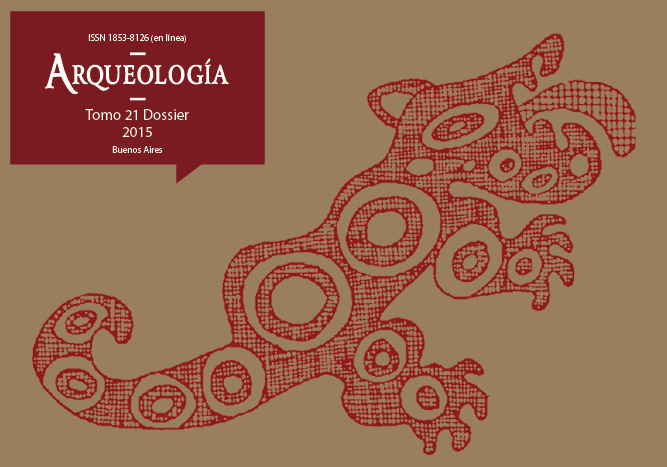La complejidad social en Aguada. El caso del Valle de Antinaco, departamento de Famatina, Norte de la provincia de La Rioja (Argentina)
Palabras clave:
Aguada, Ideología religiosa, Complejidad social, Modos de organización social, Valle de Antinaco
Resumen
A partir del desarrollo del fenómeno Aguada durante el Período Medio tuvo lugar un proceso de complejización social en la región valliserrana que se manifestó con características específicas en cada zona, lo cual favoreció la construcción de identidades locales. En todos los ámbitos de la región se evidencia: a) un aumento poblacional que se traduce en la cantidad, escala y funcionalidad de los sitios; b) la presencia de un patrón de instalación jerarquizado, tanto en el tamaño como en la estructuración interna de los asentamientos; y c) el uso de un repertorio iconográfico vinculado a cierta ideología religiosa. Atendiendo a estas evidencias, se realizan algunas consideraciones generales sobre la complejidad y los modos de organización social de las sociedades que formaron parte de este fenómeno y, específicamente, sobre las que habitaron en el Valle de Antinaco, en el norte de la provincia de La Rioja. Se parte de la idea de que los paisajes son el resultado de la representación que cada comunidad hizo de ellos, y que los monumentos y el ritual asociado tuvieron una vital significación en la creación y reproducción de la autoridad de aquellos individuos instruidos en sus saberes. De acuerdo con esto, se analiza la traza arquitectónica del sitio La Cuestecilla y de las Aldeas circundantes, haciendo referencia también a otras materialidades recuperadas en los sitios intervenidos.Descargas
La descarga de datos todavía no está disponible.
Cómo citar
Callegari, A., Spengler, G., & Rodríguez, M. G. (1). La complejidad social en Aguada. El caso del Valle de Antinaco, departamento de Famatina, Norte de la provincia de La Rioja (Argentina). Arqueología, 21(3), 111-137. https://doi.org/10.34096/arqueologia.t21.n0.2379
Sección
Artículos
Los autores/as que publiquen en esta revista aceptan las siguientes condiciones:
- Los autores/as conservan los derechos de autor y ceden a la revista el derecho de la primera publicación, con el trabajo registrado mediante Licencia Creative Commons 4.0 Internacional (CC-BY-NC-SA), que permite a terceros utilizar lo publicado siempre que mencionen la autoría del trabajo y a la primera publicación en esta revista.
- Los autores/as pueden realizar otros acuerdos contractuales independientes y adicionales para la distribución no exclusiva de la versión del artículo publicado en esta revista (p.e. incluirlo en un repositorio institucional o publicarlo en un libro) siempre que indiquen claramente que el trabajo se publicó por primera vez en esta revista.
- Se permite y recomienda a los autores/as a publicar su trabajo en Internet (p.e. en sus sitios web personales o en depósitos institucionales), tanto antes como después de su publicación en esta revista, siempre y cuando proporcionen información bibliográfica que acredite, si procede, su publicación en ella. De esta manera, pueden favorecerse intercambios productivos y a una mayor y más rápida difusión del trabajo publicado (vea The Effect of Open Access).



.png)

(1)13.png)






1.jpg)
1.png)
1.jpg)


13.png)
1.png)


(1)1.png)









